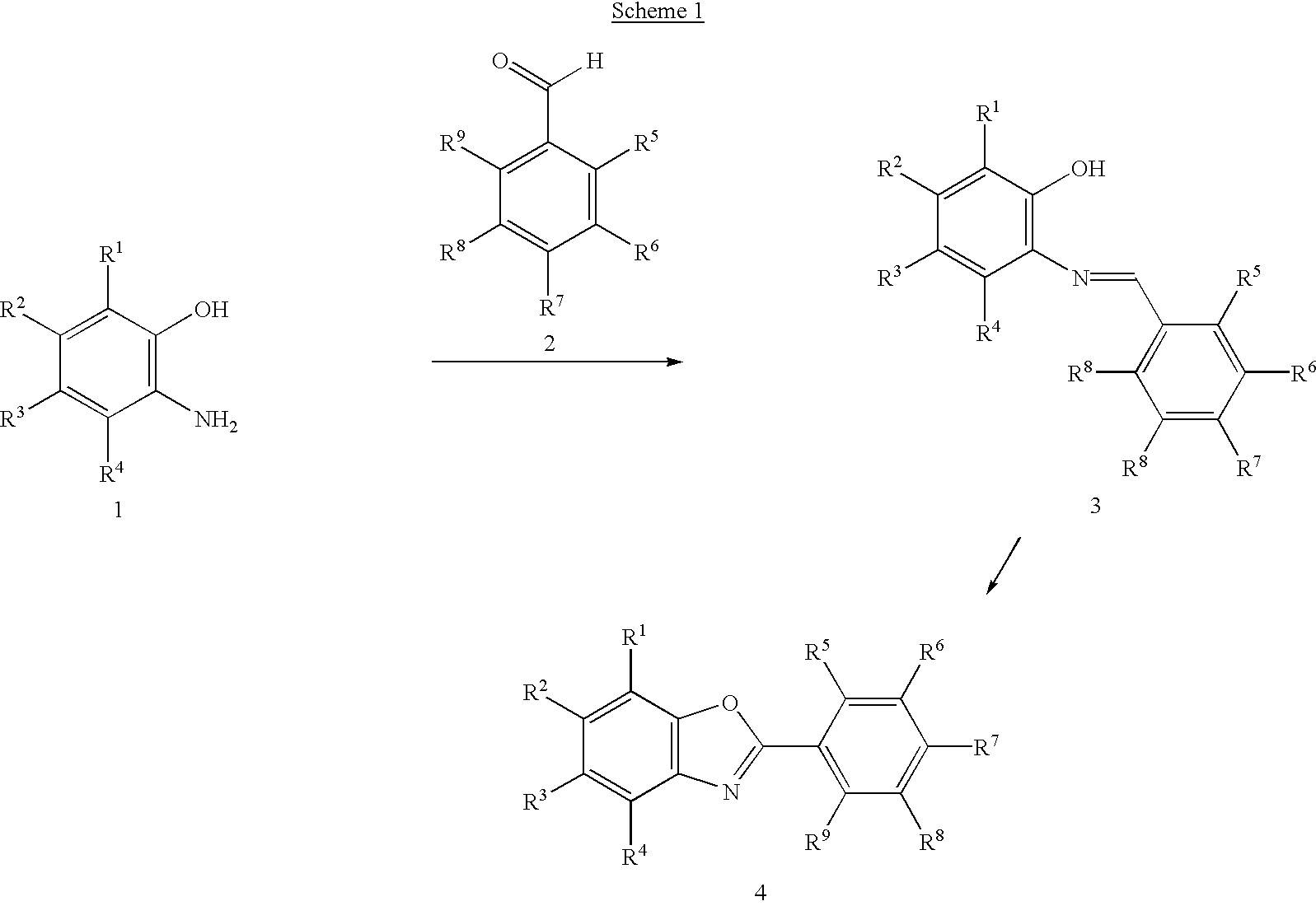Solution phase sythesis of arylbenzoxazoles
a technology of arylbenzoxazole and phase synthesis, which is applied in the field of solution phase synthesis of oxazoles, can solve problems such as inadequacies in the use of substrates
- Summary
- Abstract
- Description
- Claims
- Application Information
AI Technical Summary
Benefits of technology
Problems solved by technology
Method used
Image
Examples
example 1
A representative experimental procedure is as follows: To a solution of 2-aminophenol (0.109 g, 1.0 mmol) in MeOH (5 mL) was added p-anisaldehyde (0.136 g, 1.0 mmol). The resulting mixture was heated at 45° C. for 12 h. After concentration under reduced pressure, the residue was dissolved in CH2Cl2 (10 mL) and DDQ (0.250 g, 1.1 mmol) was then added. After stirring at room temperature for 30 min, the resulting mixture was diluted with additional CH2Cl2 (10 mL) and washed sequentially with saturated Na2CO3 (10 mL×2) and brine (10 mL). The organic layer was dried over anhydrous Na2SO4. After evaporation, the crude was purified by flash column chromatography (10% EtOAc in hexane) to afford the desired product (0.187 g, 83%). 1H NMR (400 MHz, CDCl3) δ 3.91 (s, 3H), 7.05 (d, 2H, J=9.0 Hz), 7.34 (m, 2H), 7.58 (d, 1H, 9.1 Hz), 7.76 (d, 1H, 9.0 Hz), 8.22 (d, 2H, 9.0 Hz). 13C NMR (400 MHz, CDCl3) δ 55.9, 110.8, 114.8, 120.0, 120.1, 124.8, 125.0, 129.8, 142.7, 152.6, 162.8, 164.0.
The results o...
example 2
A library of oxazoles was prepared using the general method set forth above. One prerequisite is to remove the DDP in a high throughput format. Among various purification methods available for solution-phase combinatorial synthesis, the treatment of reaction solutions with ion exchange resins has proven effective in the removal of some acidic or basic byproducts (For examples, see, Kulkarni et al., Angew. Chem. Int. Ed. Engl. 1997, 36, 2454; and Siegel et al., Tetrahedron Lett. 1997, 38, 3357), and there is a recent report demonstrating the applicability of ion exchange to a 96-well format (Bookser et al., J. Comb. Chem. 2001, 3, 205).
Basic ion-exchange resins were used to neutralize and absorb acidic DDP. Amberlite® IRA-900, which is a macroreticular resin with benzyltrialkylammonium functionality, proved to be the highly efficient in this respect. The results are summarized in Table 1 as Isolation B. The material loss, as indicated by crude yields in Table 1, was mainly due to the...
PUM
| Property | Measurement | Unit |
|---|---|---|
| diameter | aaaaa | aaaaa |
| temperature | aaaaa | aaaaa |
| heat-sensitive | aaaaa | aaaaa |
Abstract
Description
Claims
Application Information
 Login to View More
Login to View More - R&D
- Intellectual Property
- Life Sciences
- Materials
- Tech Scout
- Unparalleled Data Quality
- Higher Quality Content
- 60% Fewer Hallucinations
Browse by: Latest US Patents, China's latest patents, Technical Efficacy Thesaurus, Application Domain, Technology Topic, Popular Technical Reports.
© 2025 PatSnap. All rights reserved.Legal|Privacy policy|Modern Slavery Act Transparency Statement|Sitemap|About US| Contact US: help@patsnap.com



